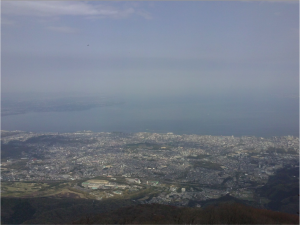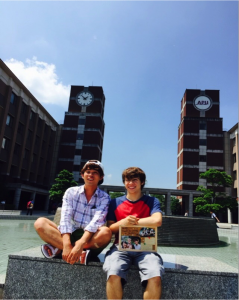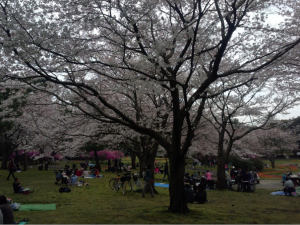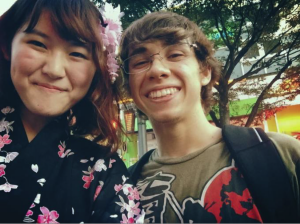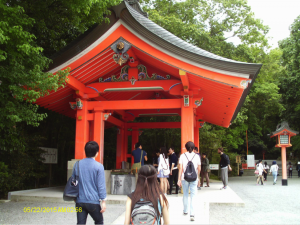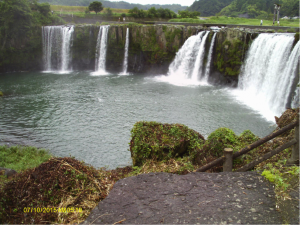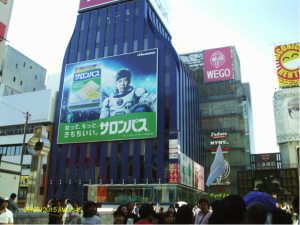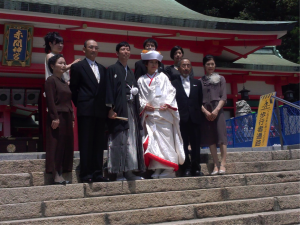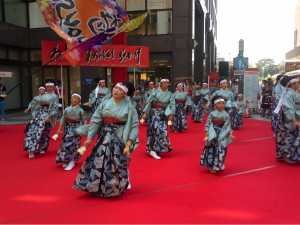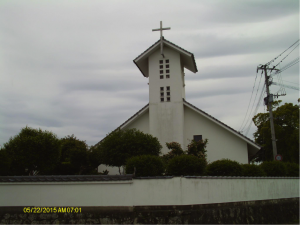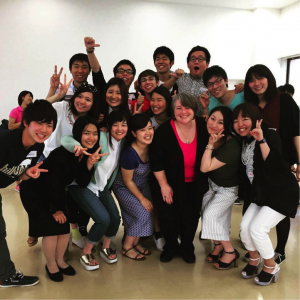By: Andreas Nicolaisen
ABSTRACT
This paper discusses my personal experiences studying abroad in japan, entailing my discoveries and thoughts on each of these individual experiences. Being able to travel to different parts of Japan, meet new people, and learn about japanese culture, i was able to determine that Japanese society highly values respect and traditions. Even with the world constantly changing and the effects it has on Japanese society, the Japanese still maintain their traditional ways of life.
Study Abroad in Beppu, Japan
During the spring semester of 2015, I studied abroad in a small town known as Beppu, located on the island of Kyushu in Japan. There I studied Japanese, adapted to and learned Japanese customs, and explored what Japan had to offer.
The photo above was taken on top of Mount Tsurumi, which is located west of Beppu, where I climbed 4,510 feet up and down. Here you can almost see the entire city.
Beppu is a small city situated between the mountains and the sea, and currently has over 125,000 people residing there. Known primarily for its hot springs, Beppu is a tourist spot for those who wish to view or relax in the naturally heated waters. During my stay there, I went to a hot spring around once a week, either by myself or with friends. In Japan it is customary to enter a hot spring fully nude, which was a bit of a culture shock to me. However, after the first experience, it was no longer uncomfortable. If you are shy about being nude around other nude people, this may not be the thing for you.
Not only is Beppu famous for its hot springs, but it is widely known as a hub for international students. On top of one of its mountains lies Ritsumeikan Asia Pacific University (APU), where people from all over the world come to study. There I studied for 4 and half months, and if there is anything to note, it’s that the whole campus promotes the spreading of different cultures. Every other week is tied to a different theme (Thailand, Korea, etc.) and students will use that week to promote a certain country’s culture through food, games, and performances.
The springtime viewing of the blooming cherry blossoms, known as hanami, is popular in Beppu park. They only come around in early April, so you have to be there before then to see them. A group of exchange students and I came here during the week and had a picnic under the cherry blossom trees, and it was breathtaking to say the least. This is a special tradition to partake in throughout Japan, so being able to be part of it was a memorable experience.
During the summer, Beppu throws a number of festivals where hundreds of citizens from a number of neighboring cities come to partake. Normally people wear yukatas, which are Japanese-style summer clothing, during the festivals. You can find dozens of food stands selling all types of Japanese treats, from octopus to candied apples. At the end of the festival, fireworks are shot off of boats on the sea. It was one of the most beautiful things that I witnessed in Japan and it shows just how serious the Japanese are about making a fantastic festival.
Shrines are common to see around Japan. Both tourists and locals often visit shrines such as the one pictured above. This structure has water fountains where guests wash their hands and drink the water to purify themselves before entering the actual shrine. Further inside you can buy good luck charms and fortunes at the shops available.
Pictured above is the Kinkakuji Temple (also known as the Golden Pavilion), which is located in Kyoto. A beautiful structure and world heritage site, Kinkakuji is actually covered in gold, making it shine gorgeously across the water. When visiting here, I discovered that there is a big difference between shrines and temples. The main difference is the religious affiliation associated with them as temples are known to have Buddhist influence whereas shrines are primarily influenced by Shinto.
Japan’s geographical position makes it a country prone to earthquakes and tsunamis. As of April 2017, Kumamoto and the island of Kyushu suffered a magnitude 7 earthquake that caused buildings to partially collapse and other property damage. During my stay in Beppu, I experienced an earthquake first hand. Around 4 a.m., the dormitory I was staying in began to quake, causing loose items to fall as well as awakening the other residents. Although it was only for a few seconds and was not high on the Richter scale, it was strong enough that everyone noticed it. Living next to the sea made the experience more frightening as a tsunami could have resulted if the quake was strong enough. Because of the high frequency of earthquakes, the buildings are built in ways that make it much more difficult for earthquakes to destroy them.
The Harajiri Falls, located in Oita prefecture, is one of Japan’s most famous waterfalls. Here you can see the water cascading down in multiple spots, as well as the vibrant plant life surrounding it. There is also a suspension bridge where you can view the waterfalls. Even though it is a tourist spot, the amount of people there was minimal, and litter was nowhere to be seen, so I was able to fully enjoy the natural environment.
In the city of Osaka, I visited many places, from amusement parks to shopping districts. Compared to the small town of Beppu, Osaka is significantly larger, and a greater number of people means more diversity in entertainment. The dialect of Osaka’s citizens was unique as they speak with a different set of phrases and words than other parts of Japan. While I was in Kyoto, I saw that their citizens had a unique dialect to their speech as well. Although this dialect is mostly associated with older generations, younger individuals also use it to a degree.
When it comes to Japanese traditions, it does not get more traditional than a Japanese-style wedding. Here the bride and the groom wear kimonos (Japanese traditional clothing), and have the wedding take place at a Shinto style shrine. The bride and groom will sometimes have an individual perform a traditional dance for the couple as well. As traditional weddings have become rare in Japan, being able to witness one was a lucky experience for me.
Even in big cities, traditional culture still remains vibrant and alive today. Japanese-style dances are comprised of groups big and small, and are performed by people of all ages, from children to older adults. Cities and towns tend to have their own groups for specific styles of dances, and perform these dances during festivals and special events. In the city of Fukuoka I saw a variety of dances such as the one pictured above and was able to fully experience liveliness of these dancers.
Religion in Japan, although not a widely discussed topic, could still be seen in a number of places. With the exception of shrines and temples, religious structures are not common in Japan. However, as seen above, Christianity has had some influence on Japanese society. In addition to that, I myself had the pleasure of running into two Mormons during my stay in Japan. Finding out that there was a Mormon branch in the town I was staying in surprised me. Although not fully enveloped, Christianity does thrive in even the smaller parts of Japan.
One of my main influences for studying abroad was the strong relationship between Asia Pacific University and St. Edward’s University. Since 2012, students from both universities have done exchanges with each other, and have helped establish this bond that currently exists. At APU, their school planted a tree to commemorate the relationship that it has with St. Edward’s (seen above). Here in the picture are two students who studied at SEU for one summer, and when they discovered I was from St. Edward’s, we bonded instantly. This relationship between the two schools has promoted more than just the sharing of culture, but the sharing of lives as well.
The most memorable experience I had in Japan was all of the people I met and the many friends I made. The Japanese, no matter where I went, were always kind and treated me like family. Although their customs are significantly different than American ones, from mannerisms to their lifestyle, I found myself easily adapting to the culture. Before I went to Beppu, I met a group of Japanese exchange students in Austin, who are pictured above. They are the reason I wanted to go to Japan. Everything about them was interesting to me. I felt a strong connection with them, and wanted to learn everything about Japan and their culture. After going there, I accomplished these goals. This exchange was the experience of a lifetime for me, and I would not change a thing about it.
AUTHOR BIO
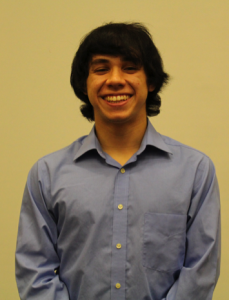 My name is Andreas Nicolaisen, and I am a recent graduate of St. Edward’s University. I am currently 22 years of age, and will have a Bachelor’s degree in Business Administration this August. My professional goals as of right now are to develop a network of connections to establish the job that I want, and to get the experience necessary to work abroad in Japan, ultimately as a business translator. As I speak Japanese to an extent and have studied abroad in Japan, I wish to work and invest my time there in the near future.
My name is Andreas Nicolaisen, and I am a recent graduate of St. Edward’s University. I am currently 22 years of age, and will have a Bachelor’s degree in Business Administration this August. My professional goals as of right now are to develop a network of connections to establish the job that I want, and to get the experience necessary to work abroad in Japan, ultimately as a business translator. As I speak Japanese to an extent and have studied abroad in Japan, I wish to work and invest my time there in the near future.

